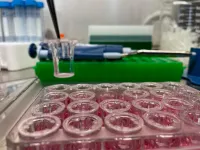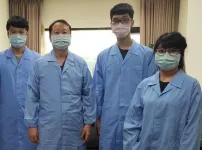(Press-News.org) COLUMBUS, Ohio - Scientists are pursuing a new strategy in the protracted fight against the SARS-CoV-2 virus by engineering nanobodies that can neutralize virus variants in two different ways.
In lab studies, researchers identified two groups of molecules that were effective against virus variants. Using different mechanisms, nanobodies in each group bypassed mutations and disabled the virus's ability to bind to the receptor that lets it enter host cells.
Though vaccination is enabling the resumption of some pre-pandemic activities in parts of the world, SARS-CoV-2 is rapidly working its way around vaccines by mutating itself. In this study, the nanobodies neutralized three emerging variants: Alpha, Beta and Gamma.
"Companies have already started introducing the variants of concern into the construct of booster shots of the existing vaccines," said Kai Xu, assistant professor of veterinary biosciences at The Ohio State University and a co-lead author of the research. "But the virus is constantly mutating, and the speed of mutation may be faster than we can capture. Therefore, we need to utilize multiple mechanisms to control the virus spread."
An accelerated article preview of the study is published online in Nature.
Nanobodies are antibodies derived from immunization of camelid mammals - such as camels, llamas and alpacas - that can be re-designed into tiny molecules that mimic human antibody structures and functions.
For this work, the researchers immunized llamas to produce single-chain antibodies against SARS-CoV-2. They also immunized "nanomice," transgenic mice with a camelid gene that had been engineered by research fellow Jianliang Xu in the lab of Rafael Casellas, senior investigator at the National Institute of Arthritis and Musculoskeletal and Skin Diseases (NIAMS), to generate nanobodies similar to those produced by camelids.
The team enhanced the nanobodies' power by immunizing the animals first with the receptor binding domain (RBD), a part of the viral surface spike protein, and following with booster shots containing the entire spike protein.
"By using this sequential immunization strategy, we generated nanobodies that can capture the virion by recognizing the receptor binding domain with very high affinity," Xu said.
The scientists tested different nanobodies' neutralization capacity, mapping the surface of the RBD, conducting functional and structure analyses, and measuring the strength of their affinity to narrow the candidate molecules from a large library to six.
The coronavirus is highly infectious because it binds very tightly to the ACE2 receptor to gain access to lung and nasal cavity cells in humans, where it makes copies of itself to infect other cells. The receptor binding domain on the spike protein is fundamental to its success in attaching to ACE2.
"That RBD-ACE2 interface is on the top of the receptor binding domain - that region is the primary target for the protective human antibodies, generated by vaccination or previous infection, to block the viral entry," Xu said. "But it is also a region frequently mutated in the variants."
The way mutants have emerged so far suggests long-term reliance on current vaccines will eventually be compromised, the researchers say, because antibody effectiveness is affected significantly by those mutants at the interface.
"We found that certain nanobodies can recognize a conserved region of the receptor binding domain, a hidden location that is too narrow for human antibodies to reach," Xu said. And attaching at this location, even though it is some distance away from where RBD connects to ACE2, still accomplishes what is intended - blocking SARS-CoV-2 from entering a host cell.
The other group of nanobodies, attracted to the RBD-ACE2 interface, while in their original form could not neutralize certain variants. However, when the researchers engineered this group to be homotrimers - three copies linked in tandem - the nanobodies achieved potent neutralization of the virus. Altering the structure of the nanobodies that attached to the conserved region of RBD in the same way enhanced their effectiveness as well.
There is much more research ahead, but the findings suggest nanobodies could be promising tools to prevent COVID-19 mortality when vaccines are compromised, Xu said.
"Our future plan is to further isolate antibodies specifically against emerging variants for therapeutic development, and to find a better solution for vaccines by learning from those antibodies," he said.
INFORMATION:
An HIV vaccine researcher at the NIH before joining Ohio State, Xu collaborated with multiple labs on this research. Jianliang Xu and Rafael Casellas of NIAMS, and Peter Kwong of the National Institute of Allergy and Infectious Diseases, are also equal contributors on the study. In addition to numerous NIH agencies, co-author institutions include Rockefeller University, the Aaron Diamond AIDS Research Center at Columbia University and the Frederick National Laboratory for Cancer Research.
Contact: Kai Xu, Xu.4692@osu.edu
Written by Emily Caldwell, Caldwell.151@osu.edu
MISSOULA - The map of Montana Kayla Irish pulls up is peppered with red circles, each cluster providing details behind one of today's timely topics - childhood vaccination.
The project, led by Dr. Sophia Newcomer in the University of Montana's Center for Population Health Research, is the first spatial scan analysis to identify hotspots of undervaccinated children across Montana and evaluate whether they are due to social or geographic barriers.
CPHR is funded through the National Institutes of Health, and the analysis is part of a collaborative ...
Irvine, Calif., June 21, 2021 -- Cancer immunotherapy involving drugs that inhibit CTLA-4 also activates an unwanted response that may self-limit its efficacy in fighting tumors, according to a new study led by Francesco Marangoni, Ph.D., assistant professor of physiology & biophysics and member of the Institute for Immunology at the University of California, Irvine. Study results are published online in the journal Cell.
Using a person's own immune system - immunotherapy - to treat cancer may also stimulate T regulatory cells, which are essential for preventing autoimmunity, in which the body attacks healthy cells and tissue, but limit tumor control. Some anticancer drugs of the checkpoint inhibitor family block the molecule CTLA-4 and activate ...
Every year in Canada, six trillion litres of municipal wastewater are partially treated and released into the environment, while another 150 billion litres of untreated sewage are discharged straight into pristine surface waters.
Now researchers have found a way to stem that flow: by filtering the waste through the roots of willow trees. Experimenting with a plantation in Quebec, the scientists estimate that over 30 million litres of primary wastewater per hectare can be treated using 'bio-refinery' annually.
Their results were published June 14 in the journal ...
[Brooklyn, New York] - [June 21, 2021] - Applied Biological Laboratories (Applied Bio), a biopharmaceutical company focused on the respiratory disease market, announced that its study published online in Immunology, Inflammation and Disease was able to determine the mechanism behind respiratory inflammation and treat it effectively with Biovanta(TM), a 100% naturally derived, over-the-counter (OTC) drug for cold, cough and sore throat.
The study results also showed that almost all of the leading OTC products on the market can damage the upper respiratory cells and may prolong illness. This research study and its findings represent one of the first major breakthroughs in decades for the cold and flu market.
The study, titled ...
UNIVERSITY PARK, Pa. -- Clickbait headlines might not be as enticing to readers as once thought, according to a team of researchers. They added that artificial intelligence -- AI -- may also come up short when it comes to correctly determining whether a headline is clickbait.
In a series of studies, the researchers found that clickbait -- headlines that often rely on linguistic gimmicks to tempt readers to read further -- often did not perform any better and, in some cases, performed worse than traditional headlines.
Because fake news is a concern on social media, researchers have explored using AI to systematically identify and block clickbait. However, the studies also suggest ...
Amazon rain forests could be at far higher risk of extreme drought than previously thought, according to new research.
An international study, led by the University of Leeds, warns that huge areas in the eastern part of the Amazon face severe drying by the end of the century if action is not taken to curb carbon emissions.
As a result, large amounts of carbon dioxide would be released from the forest into the atmosphere,
adding to the greenhouse gas effect and driving further climate change.
The increased dryness during the Amazon dry season would further threaten the viability of large parts of the rainforest, as trees are already water stressed and there is greater risk of forest fires.
The predicted droughts could also have far-reaching consequences ...
Vanadium oxo (VO) species were often used to oxidise sulfide/amine compounds and alkenes when combined with peroxide oxidants. VO species are well known as important vitamin supplements for potential diabetic prevention. They are highly prevalent as metalloenzyme like haloperoxidase. The current catalyst class comprises VO species, substituted-salicylaldehyde, and alpha-amino acids that are nontoxic and highly enriched in ascidian sea animals and plants. Professor Chien-Tien Chen of NTHU pioneered aerobic asymmetric couplings of 2-naphthol with VO species to form optically active binaphols in 2001 (reported in C&EN News, 79(20), 45-57(2001)), which was believed to proceed in a VO-bound, single/dual-mode activation or free radical-radical/free ...
What causes an eruption? Why do some volcanoes erupt regularly, while others remain dormant for thousands of years? A team of geologists and geophysicists, led by the University of Geneva (UNIGE), Switzerland, has reviewed the literature on the internal and external mechanisms that lead to a volcanic eruption. Analyzing the thermo-mechanics of deep volcanic processes and magma propagation to the surface, together with magma chemistry, the geologists determined that most of the magma rising from depth actually does not cause a volcanic eruption. They also show that older volcanoes tend to produce less frequent, but larger and more dangerous eruptions. Their findings, published in Nature Reviews ...
A new study published in Nature Communications demonstrates the important role that planting new commercial forests could play in the fight against climate change by including new accounting of greenhouse gas (GHG) mitigation achieved from future use of harvested wood.
The study applied a novel, time-dependent assessment to capture the complex dynamics of carbon uptake, storage and partial eventual release back to the atmosphere, alongside product and energy substitution by wood products, over a 100-year timeframe.
Uniquely, the study considered multiple wood uses along multi-decadal cascading value chains (e.g. construction timber to paper to bioenergy), and future projections on wider decarbonisation of substituted ...
Although the emissions targets for aviation are in line with the overall goals of the Paris Agreement, there is a high likelihood that the climate impact of aviation will not meet these goals, according to a new study.
Aviation is an important contributor to the global economy, but contributes to climate change by creating carbon dioxide (CO2) as well as non-CO2 effects such as forming nitrogen oxides, ozone and contrailcirrus clouds, which all contribute to global warming.
Researchers believe that, as long as the industry stages a recovery, the restrictions placed on global air travel in response to COVID-19 lockdown will only have ...




